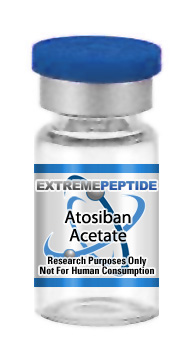(Click here to read our disclaimer)
Antosiban acetate is commonly researched for its potential in stopping premature labor. The applications and effects of this chemical will vary based on which animals it is being applied to and how it is intended to be used. Most research focuses on applying this peptide to female animals given its natural role in reproductive health within the body.
While this medication is commonly used in European countries to better manage premature labor between the 24-33 weeks of pregnancy by blocking oxytocin in the body, it is not approved nor recommended for this or any other use by individuals in the United States.
While antosiban has been shown to be helpful in managing reproductive health issues it has also been shown to contribute to kidney problems, liver problems, placental abruption, placenta praeia or premature rupture of membranes when applied to animals in research settings. Research is ongoing to better understand what applications of this chemical increase the likelihood of these effects to better understand the workings of this chemical and its potential future medical uses.
Preparing Atosiban Acetate
The following measures should be followed when preparing atosiban acetate for laboratory use.
- Dissolve the product in an aqueous acetonitrile solution using aqueous ammonia and oxidized water filtering to adjust the pH value and purify the substance. You can slowly convert the substance to a salt to obtain the necessary atosiban acetate.
- This method is considered ideal for those that will need to harvest large portions of this chemical because atosiban acetate can be very difficult to dissolve.
This method will also shorten the reaction time to a more reasonable option so it is easy to industrialize the product without compromising the quality or the purity of the product which would be necessary for clinical research.
Visual Compatibility of the Chemical
Many animals exposed to atosiban acetate for research purposes are also exposed to similar chemicals which will need to be presented with care.
- Research for intrauterine infections or endometriosis will often revolve around applying atosiban acetate with amoxicilling clavulanic acid or magnesium sulfate and ketanserin. There is not yet information available about the reactions of this combination.
- Atosiban acetate is typically applied to animals using a sterile aqueous concentrate that is preservative free and contanes acetate sale as well as mannitol to adjust the pH as necessary for the given application.
It is recommended that any solutions with atosiban acetate be applied in a 1:1 ratio. This will allow the solution to retain as much of the original properties of the chemicals as possible during study to ensure accurate and reliable results.
There have been some contradictions regarding the science behind using atosiban acetate in research settings. Some have found that preparations of vitamins may provide a complimentary effect when applied alongside this chemical. However, it has also been found that if this chemical is applied to animals that have also been exposed to known medications containing calcium channel blockers, tocolytic activity or beta mimetics it can produce negative effects that are potentially fatal for the animal.
Sources:
http://patentscope.wipo.int/search/en/WO2012083861
http://www.ajhp.org/content/62/23/2459.extract
Click here to view our entire PDF research library
Click here to view/download the PDF version of this article
